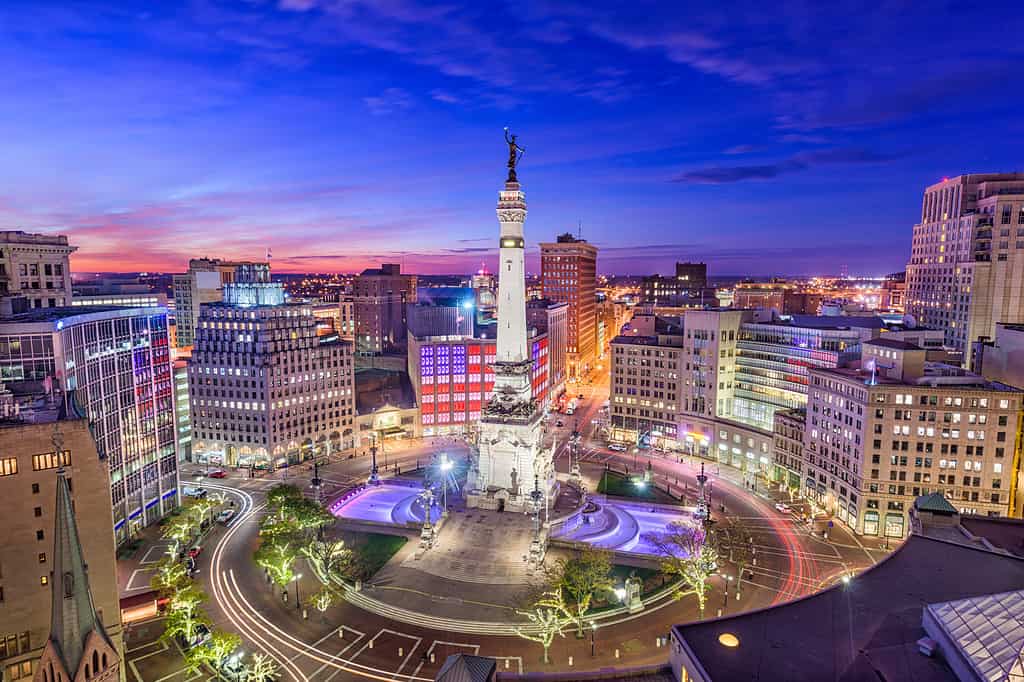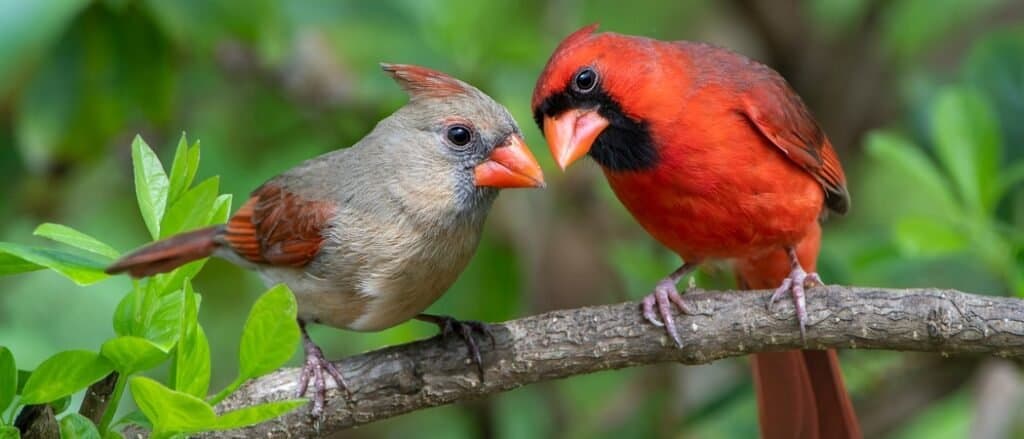Indiana is a Midwestern state best known for its major attraction – Indiana Dunes National Park. That’s not all this fine state holds – Indiana is unique in several ways. From the Garfield sculptures in Fairmount to the deep caves of southern Indiana, there is so much to explore when you visit or live in the state. In this article, we’ll be taking a look at the total distance from north to south, along with learning about the population, major cities, and wildlife Indiana contains. How tall is Indiana? We have your answer, so read on.
How Tall is Indiana?

Indiana is called “The Crossroads of America” due to its central location at the junction of four major United States Highways.
©Peterfitzgerald / This picture is not protected by copyright. The original creator released it into the public domain and has released all rights. This applies worldwide. – Original / License
At its tallest point, Indiana measures 270 miles north to south. This is in contrast to its 140-mile width. Indiana is nearly two times as tall as it is wide. The overall size of the state is 36,420 square miles. How does this stack up against other states? Check out this handy table of seven states in the United States for comparison. This table includes the largest and smallest states in the United States along with five others that are similar in size to Indiana. We have highlighted in bold the state whose total distance from north to south is most similar to that of Indiana.
There is a lot of contesting information about the square mileage of each state. We have used the United States Census Bureau as our source of information. However, several state government websites contest these numbers, proving that it is quite difficult to get accurate information online and that you should do plenty of research to confirm your findings.
| State | Width (East to West) | Length (North to South) | Overall Size | Total Population (2021 Census) |
|---|---|---|---|---|
| Alaska | 2,400 miles | 1,420 miles | 665,384 square miles | 732,673 |
| Maine | 210 miles | 320 miles | 35,380 square miles | 1,385,341 |
| South Carolina | 200 miles | 260 miles | 32,020 square miles | 5,118,429 |
| Kentucky | 187 miles | 397 miles | 40,408 square miles | 4,512,310 |
| Tennessee | 432 miles | 112 miles | 42,143 square miles | 6,910,840 |
| Virginia | 430 miles | 200 miles | 42,775 square miles | 8,863,619 |
| Rhode Island | 37 miles | 48 miles | 1,545 square miles | 1,097,371 |
Where is Indiana on a Map?
Check out this helpful interactive map to get a better idea of where Indiana is on a map. Even at a glance, you can see a spiderweb of highways all intersecting in Indianapolis. Take a closer look to see the river that separates Indiana from Kentucky on its southern border. You can also see where Illinois borders Indiana to the west. In the northwesternmost corner, Lake Erie helps to define the state’s border before becoming the lands of Michigan to the north. On the eastern side, Ohio shares a border with Indiana.
You can also clearly see the capital city of Indianapolis, which rests in the central portion of Indiana, and Fort Wayne, another of Indiana’s larger cities, to the northeast.
Population and Cost of Living

Indianapolis is the largest city by population in the entire state of Indiana.
©Sean Pavone/ via Getty Images
According to the United States Census Bureau, Indiana has a total population of 6,833,037. 84 percent of the overall population is white, while only 10.3 percent is Black or African American, 7.9 percent is Hispanic or Latino, and 2.8 percent is Asian. Just over half of the population is identified as female. 16.9 percent of Indiana is described as “Persons 65 years and over”. There are 2,622,601 households across the state with an average of 2.5 people per household. 91 percent of these households have a computer.
The average cost of living in Indiana, according to a living wage calculator designed by MIT, is $32,834 (pre-tax). The average income for an individual in Indiana is $30,902.
Major Cities
Indiana has only six cities with a population of over 100,000. We’ll list these cities in a handy table that will show you the name of the city, the population of that city according to the 2021 census, the average income, and a fun fact about the city. This will help you get a basic outline of each city’s average wage and population. You’ll see that average income varies greatly from city to city.
| City | Population | Average Annual Income | Fun Fact |
|---|---|---|---|
| Indianapolis | 882,039 | $30,727 | Home to the world’s largest Children’s Museum. |
| Fort Wayne | 265,974 | $29,712 | There are 360 churches in Fort Wayne. |
| Evansville | 116,486 | $25,525 | Home of the oldest public library in Indiana. |
| South Bend | 103,353 | $25,595 | Home to the largest collection of Presidential carriages. |
| Fishers | 101,171 | $52,603 | Only 350 people lived in Fishers in 1963 and only 7,500 lived there in 1990. |
| Carmel | 100,777 | $53,670 | Contains 140 roundabouts. |
Wildlife in Indiana

Indiana doesn’t have an official state animal but it does have an official state bird: the
Northern Cardinal
.
©Bonnie Taylor Barry/Shutterstock.com
Indiana is home to a plethora of wildlife, including over 60 species of mammals. Some small mammals you might encounter are chipmunks, gray squirrels, groundhogs, Indiana bats, minks, opossums, raccoons, red foxes, and striped skunks. Larger mammals include white-tailed deer, mountain lions, feral hogs, and black bears.
Plenty of fish swim in the rivers and lakes of Indiana. Fishermen are happy to catch crappies, catfish, muskies, and Northern pike. Other fish species include lampreys, American eels, paddlefish, trout, and sunfish. Plenty of reptiles and amphibians are found in the riparian areas of Indiana. Listen to the bullfrogs croak on a spring evening or keep an eye out for snapping turtles, Eastern hog-nosed snakes, and green salamanders. You might also spot a gray ratsnake, a spring peeper, or a timber rattlesnake.
We haven’t forgotten about birds. Indiana is a great place for birdwatching. Take some time to look out for Canadian geese, cardinals, osprey, peregrine falcons, barn owls, and bald eagles. Remember that wild animals need a good amount of space and natural habitat to thrive. You should never approach wild animals unless you are a trained expert in wildlife. This is for your safety as well as the safety of these precious animals. Many animals face endangerment and extinction due to habitat loss, and we must be careful to not contribute to the problem.
Fun Facts About Indiana

Indiana is home to one of the most famous American races – the Indy 500.
We thought we’d finish out with some cool facts about the state of Indiana. Maybe one of them will pique your curiosity and you’ll want to explore this Midwestern state further. Maybe you’re a resident who will learn a little bit more about your home state. Either way, we hope you enjoy these fun facts as much as we enjoyed putting them together for you!
- Indiana’s state flower is the Peony.
- Indiana adopted its state flag in 1917.
- Indiana is the first state to have a chapel in its state capital.
- Indiana was the 19th state to enter the Union.
- Elvis Presley played his very last concert in Indiana on June 26th, 1977 at Market Square Arena in Indianapolis.
- Indiana is one of the world’s top producers of popcorn.
- Jim Davis, the creator of “Garfield the Cat” was born in Marion, Indiana.
- The Jackson 5 began their career in Gary, Indiana.
- Indiana is one of only 13 states to exist in two or more time zones.
- The Indiana Dunes are known as the “birthplace of ecology”.
- There are over one hundred wineries in Indiana.
- Parke County in Indiana is known as “The Covered Bridge Capital of the World”.
- Indiana is called the “Hoosier” state, but no one knows exactly why it is called that.
- The state is home to the first train robbery in American history.
- Indiana was home to “The Grand Central Station of the Underground Railroad”.
- Illinois may be known as “The Land of Lincoln”, but the 16th President of the United States was born in Kentucky and grew up in Indiana.
The photo featured at the top of this post is © iStock.com/Oleksii Liskonih
Thank you for reading! Have some feedback for us? Contact the AZ Animals editorial team.







